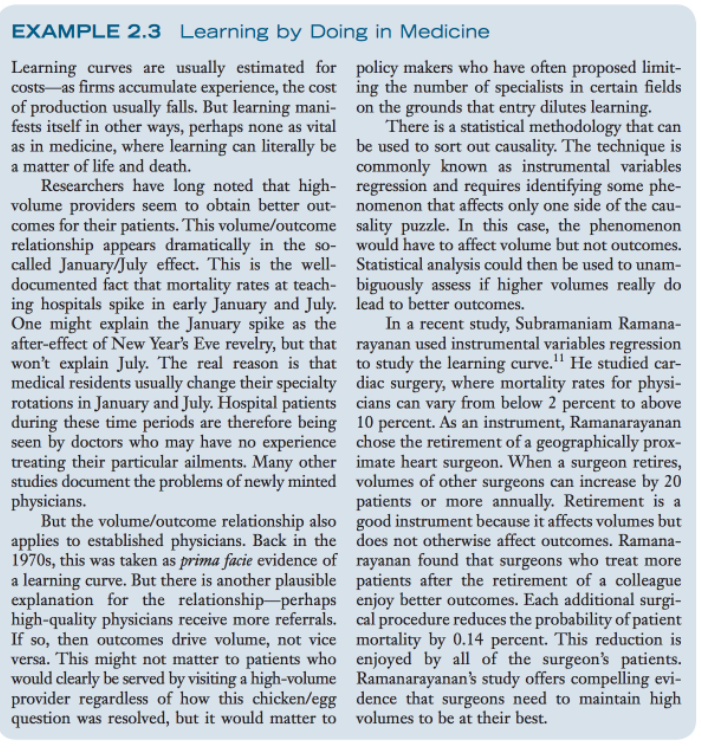Using the case study from the textbook; give an example of other industries that do the same as the example below - I am stumped and not sure what other example I could use that uses instrumental variable regression analysis.
References
Besanko, D., Dranove, D., Shanley, M., & Schafer, S. (2016). Economics of Strategy (7th Edition). John Wiley & Sons, Inc.

EXAMPLE 2.3 Learning by Doing in Medicine Learning curves are usually estimated for policy makers who have often proposed limit- costsas firms accumulate experience, the costing the number of specialists in certain fields of production usually falls. But learning mani- on the grounds that entry dilutes learning. fests itself in other ways, perhaps none as vital There is a statistical methodology that can as in medicine, where learning can literally be be used to sort out causality. The technique is a matter of life and death. commonly known as instrumental variables Researchers have long noted that high- regression and requires identifying some phe- volume providers seem to obtain better out- nomenon that affects only one side of the cau- comes for their patients. This volume/outcome sality puzzle. In this case, the phenomenon relationship appears dramatically in the so- would have to affect volume but not outcomes. called January/July effect. This is the well- Statistical analysis could then be used to unam- documented fact that mortality rates at teach- biguously assess if higher volumes really do ing hospitals spike in early January and July. lead to better outcomes. One might explain the January spike as the In a recent study, Subramaniam Ramana- after-effect of New Year's Eve revelry, but that rayanan used instrumental variables regression won't explain July. The real reason is that to study the learning curve." He studied car- medical residents usually change their specialty diac surgery, where mortality rates for physi- rotations in January and July. Hospital patients cians can vary from below 2 percent to above during these time periods are therefore being 10 percent. As an instrument, Ramanarayanan seen by doctors who may have no experience chose the retirement of a geographically prox- treating their particular ailments. Many other imate heart surgeon. When a surgeon retires, studies document the problems of newly minted volumes of other surgeons can increase by 20 physicians. patients or more annually. Retirement is a But the volume/outcome relationship also good instrument because it affects volumes but applies to established physicians. Back in the does not otherwise affect outcomes. Ramana- 1970s, this was taken as prima facie evidence of rayanan found that surgeons who treat more a learning curve. But there is another plausible patients after the retirement of a colleague explanation for the relationship-perhaps enjoy better outcomes. Each additional surgi- high-quality physicians receive more referrals. cal procedure reduces the probability of patient If so, then outcomes drive volume, not vice mortality by 0.14 percent. This reduction is versa. This might not matter to patients who enjoyed by all of the surgeon's patients. would clearly be served by visiting a high-volume Ramanarayanan's study offers compelling evi- provider regardless of how this chicken/egg dence that surgeons need to maintain high question was resolved, but it would matter to volumes to be at their best







